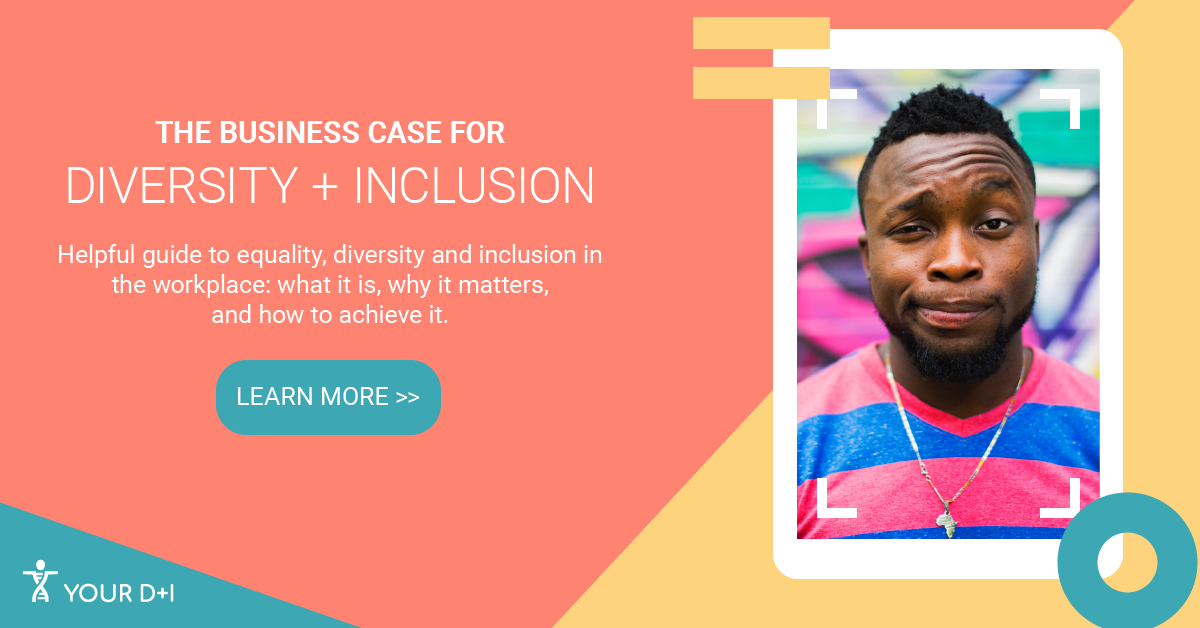The Business Case For Equality, Diversity And Inclusion
Who are the people in your workforce? Do they all look, think and talk like you? Or are they all from different walks of life? Maybe some of them are treated differently and it’s affecting their performance, for better or worse? Equality, diversity and inclusion isn’t about political correctness or being best buddies with your colleagues. It’s about getting the best talent, a more productive work environment and the best results for your business. This is called the business case for equality, diversity and inclusion.
Here’s a helpful guide to equality, diversity and inclusion in the workplace: what it is, why it matters, and how to achieve it.
What is equality, diversity and inclusion?
Equality, diversity and inclusion all have the same aim – to create a level playing field in the workplace. But they each serve a particular purpose for employers and employees.
Let’s look at each one in turn:
Equality means that everyone is treated fairly and that no one is discriminated against for any reason. Everyone has access to the same opportunities.
Diversity is the range of individuals that are in your workforce. This includes gender, ethnicity, age, sexual orientation, religion and people with learning or physical disabilities.
Inclusion means that everyone feels like they’re a valued part of the team.
Your business and your employees will see much better results if you commit to these three things together.
Employers must follow the law on equality and discrimination.
Employers are legally responsible for protecting their employees from discrimination in the workplace. Breaking the law can be very costly. Discrimination cases can result in lost time, lost money and a loss of trust in management. Not to mention the damage to brand reputation.
That’s why it’s so important to have clear policies for how employees should behave, how to identify discrimination and how to handle grievances.
Discrimination can affect anyone at any point in their career. It can take several forms, such as unfair pay, unfair treatment and bullying. The law lays out some ‘protected characteristics’ that employers cannot use to discriminate against someone. These include the employee’s age, sexuality, religion, race and gender.
I’m pretty sure every single person would say ‘yes’ if i asked them, ‘do you think everyone should be treated fairly and equally at work?’. But unfortunately, that’s not the reality.
In fact, workplace discrimination might be costing the UK economy around £127bn per year in lost productivity, according to the Centre for Economics and Business Research. On the other hand, companies in the top quartile for ethnic diversity can increase their revenue by around 35% (McKinsey Diversity Database).
So there you have it: equality and diversity in the workplace can make us all better off!
Your business will appeal to more customers.
It doesn’t matter if your business is there to serve consumers or other businesses – society has become more openly diverse. Your target markets will do too, if they haven’t already. And the best way for any business to fully relate to their customers is to reflect their values and diversity in the workplace. From product development to marketing and communications, a diverse workforce can bring more expertise and fresh perspectives.
Unfortunately, there are businesses that communicate diversity and inclusion in their ‘brand values’ but do very little to support it in the workplace. For example, it’s not enough just to change a logo for Pride or Black Lives Matter and to pledge support on social media. Diversity and inclusion must be embedded in the culture of your business if you really want to make a difference. And of course, if you don’t practice what you preach, you could be in for a PR disaster.
You’ll attract a better range of talent.
When people don’t have the right connections, it can be hard for them to access certain professions or senior positions. In some cases, it can be physically impossible or uncomfortable for candidates to access the places they need to go. This creates a risk that people who are perfect for the job don’t even apply.
This isn’t just an issue for minority groups, though it is more likely to affect them. It could also be people who need the flexibility to balance work and family life, or even people whose age could be a barrier to success.
From a business perspective, it doesn’t make sense to form barriers to talent. These barriers could be deliberate and discriminatory or they may be unintended. They could even be unconscious.
‘Unconscious bias’ is when people make fast judgements based on stereotypes. It could be a common social stereotype, or it could be based on personal experience. For example, a candidate could get ahead in the hiring process simply because of the university they went to, or be left out because of how they look.
It’s fair to say that humans can be pretty judgemental creatures. So it’s a good job that employers can overcome this through awareness training and better designed recruitment processes.
But remember, it’s not enough just to focus your recruitment processes on diversity and inclusion. A culture of inclusion that runs through the whole business will mean your people are much more likely to stay on board.
Employees will want to keep working for you.
Hands up who wants to feel miserable and excluded at work every day?
That might seem like a stupid question. But in some companies and for some people, it seems to be a fixture of working life. This is clearly bad news for employers as well as their staff. An unhappy workplace means a higher staff turnover, lower morale and lower productivity. These are all things that can hit your finances.
Equality, inclusion and diversity can really help to create a positive working culture. But it’s so much more than just an HR exercise. Your whole company culture must be geared towards supporting people and treating them fairly. From the recruitment policies to everyday behaviours, it’s an ongoing process that affects everyone.
A great example of this is was a prominent public service company and their quest to diversify their workforce. They had reported a 40% increase in their BAME hires in 2018, following a successful recruitment campaign. But then 40% of these new starters dropped out within the first year. The desire for diversity was there. But nothing had been put in place to make those employees feel included and supported once they started work.
After realising this they went on to develop a successful diversity and inclusion programme. This really shows how diversity and equality isn’t just about getting bums on seats; it’s about embedding it into your company culture.
We know that harassment can happen to anyone, at any time in their working life. Bullying can even become the norm in some workplaces. So it’s crucial to have clear policies on how to recognise, report and handle cases of harassment. This will make discrimination less likely and create a better all-round working environment.
When your business sees and treats people as individuals rather than just employees, everyone’s a winner!
How can your own business benefit from equality, diversity and inclusion?
And that concludes the business case for equality, diversity and equality! We’d love to have a chat to you about what you’re trying to achieve for your business when it comes to your diversity and inclusion. Head over to our let’s talk page and submit your details, i’ll get back in touch with you shortly!


